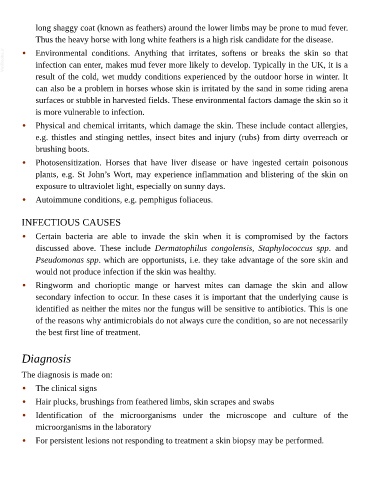Page 824 - The Veterinary Care of the Horse
P. 824
long shaggy coat (known as feathers) around the lower limbs may be prone to mud fever.
Thus the heavy horse with long white feathers is a high risk candidate for the disease.
VetBooks.ir • Environmental conditions. Anything that irritates, softens or breaks the skin so that
infection can enter, makes mud fever more likely to develop. Typically in the UK, it is a
result of the cold, wet muddy conditions experienced by the outdoor horse in winter. It
can also be a problem in horses whose skin is irritated by the sand in some riding arena
surfaces or stubble in harvested fields. These environmental factors damage the skin so it
is more vulnerable to infection.
• Physical and chemical irritants, which damage the skin. These include contact allergies,
e.g. thistles and stinging nettles, insect bites and injury (rubs) from dirty overreach or
brushing boots.
• Photosensitization. Horses that have liver disease or have ingested certain poisonous
plants, e.g. St John’s Wort, may experience inflammation and blistering of the skin on
exposure to ultraviolet light, especially on sunny days.
• Autoimmune conditions, e.g. pemphigus foliaceus.
INFECTIOUS CAUSES
• Certain bacteria are able to invade the skin when it is compromised by the factors
discussed above. These include Dermatophilus congolensis, Staphylococcus spp. and
Pseudomonas spp. which are opportunists, i.e. they take advantage of the sore skin and
would not produce infection if the skin was healthy.
• Ringworm and chorioptic mange or harvest mites can damage the skin and allow
secondary infection to occur. In these cases it is important that the underlying cause is
identified as neither the mites nor the fungus will be sensitive to antibiotics. This is one
of the reasons why antimicrobials do not always cure the condition, so are not necessarily
the best first line of treatment.
Diagnosis
The diagnosis is made on:
• The clinical signs
• Hair plucks, brushings from feathered limbs, skin scrapes and swabs
• Identification of the microorganisms under the microscope and culture of the
microorganisms in the laboratory
• For persistent lesions not responding to treatment a skin biopsy may be performed.

